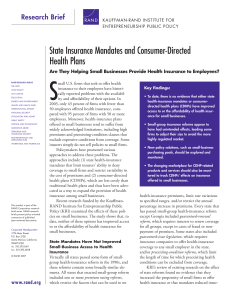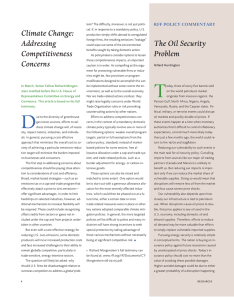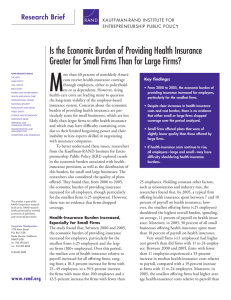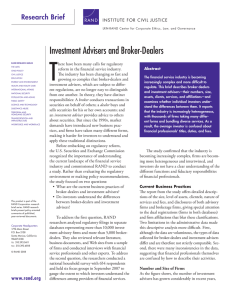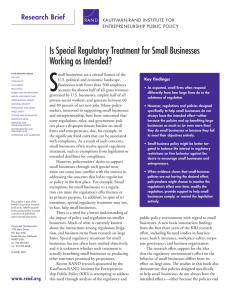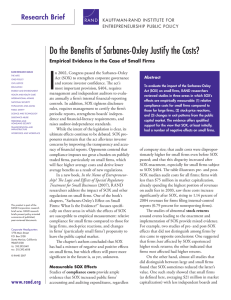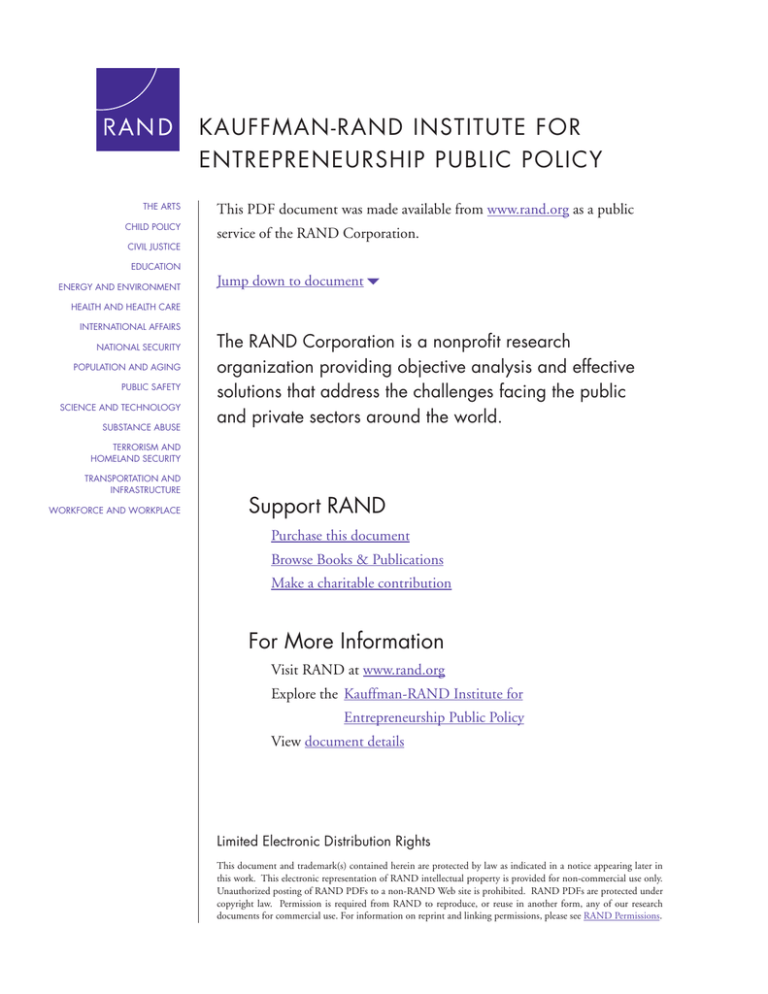
KAUFFMAN-RAND INSTITUTE FOR
ENTREPRENEURSHIP PUBLIC POLICY
THE ARTS
CHILD POLICY
CIVIL JUSTICE
EDUCATION
ENERGY AND ENVIRONMENT
This PDF document was made available from www.rand.org as a public
service of the RAND Corporation.
Jump down to document6
HEALTH AND HEALTH CARE
INTERNATIONAL AFFAIRS
NATIONAL SECURITY
POPULATION AND AGING
PUBLIC SAFETY
SCIENCE AND TECHNOLOGY
SUBSTANCE ABUSE
The RAND Corporation is a nonprofit research
organization providing objective analysis and effective
solutions that address the challenges facing the public
and private sectors around the world.
TERRORISM AND
HOMELAND SECURITY
TRANSPORTATION AND
INFRASTRUCTURE
WORKFORCE AND WORKPLACE
Support RAND
Purchase this document
Browse Books & Publications
Make a charitable contribution
For More Information
Visit RAND at www.rand.org
Explore the Kauffman-RAND Institute for
Entrepreneurship Public Policy
View document details
Limited Electronic Distribution Rights
This document and trademark(s) contained herein are protected by law as indicated in a notice appearing later in
this work. This electronic representation of RAND intellectual property is provided for non-commercial use only.
Unauthorized posting of RAND PDFs to a non-RAND Web site is prohibited. RAND PDFs are protected under
copyright law. Permission is required from RAND to reproduce, or reuse in another form, any of our research
documents for commercial use. For information on reprint and linking permissions, please see RAND Permissions.
This product is part of the RAND Corporation technical report series. Reports may
include research findings on a specific topic that is limited in scope; present discussions of the methodology employed in research; provide literature reviews, survey
instruments, modeling exercises, guidelines for practitioners and research professionals, and supporting documentation; or deliver preliminary findings. All RAND
reports undergo rigorous peer review to ensure that they meet high standards for research quality and objectivity.
The Economic Burden of
Providing Health Insurance
How Much Worse Off Are
Small Firms?
Christine Eibner
Supported by the Ewing Marion Kauffman Foundation
KAUFFMAN-RAND INSTITUTE FOR
ENTREPRENEURSHIP PUBLIC POLICY
The research described in this report was conducted within the Kauffman-RAND Institute
for Entrepreneurship Public Policy in the RAND Institute for Civil Justice (ICJ). ICJ
research is supported by pooled grants from corporations, trade and professional associations,
and individuals; by government grants and contracts; and by private foundations.
Library of Congress Cataloging-in-Publication Data is available for this publication.
ISBN #978-0-8330-4411-2
The RAND Corporation is a nonprofit research organization providing objective analysis
and effective solutions that address the challenges facing the public and private sectors
around the world. RAND’s publications do not necessarily reflect the opinions of its
research clients and sponsors.
R® is a registered trademark.
© Copyright 2008 RAND Corporation
All rights reserved. No part of this book may be reproduced in any form by any electronic or
mechanical means (including photocopying, recording, or information storage and retrieval)
without permission in writing from RAND.
Published 2008 by the RAND Corporation
1776 Main Street, P.O. Box 2138, Santa Monica, CA 90407-2138
1200 South Hayes Street, Arlington, VA 22202-5050
4570 Fifth Avenue, Suite 600, Pittsburgh, PA 15213-2665
RAND URL: http://www.rand.org
To order RAND documents or to obtain additional information, contact
Distribution Services: Telephone: (310) 451-7002;
Fax: (310) 451-6915; Email: order@rand.org
Summary
More than 60 percent of nonelderly Americans receive health-insurance coverage through
employers, either as policyholders or as dependents. However, rising health-care costs are leading many to question the long-term viability of the employer-based insurance system. Concerns about the economic burden of providing health insurance are particularly acute for small
businesses, which are both less likely than larger firms to offer health insurance and more sensitive to price when deciding to offer insurance. Small firms may have difficulty containing costs
due to their limited bargaining power and their inability to hire experts skilled in negotiating
with insurance companies. Further, while few recent studies have systematically explored differences in the quality of health-insurance plans that small and large firms offer, there is some
evidence to suggest that small firms may offer health plans of lower quality.
To better understand these issues, researchers from the Kauffman-RAND Institute for
Entrepreneurship Public Policy (KRI) explored trends in the economic burden associated with
health-insurance provision, as well as the distribution of this burden, for small and large businesses. Researchers also considered the quality of plans that small and large firms offer.
To measure economic burden, researchers examined firms’ health-insurance spending
relative to payroll. To understand the generosity of health-insurance plans offered, researchers
reviewed specific plan characteristics as well as the predicted actuarial value of the plans. Data
for these analyses come from the Employment Cost Index (ECI), a quarterly survey of businesses conducted by the U.S. Bureau of Labor Statistics (BLS), as well as the Employee Benefits
Survey (EBS), a periodic survey of employer health plans that BLS also conducts.
Health-Insurance Burden Increased, Especially for Small Firms
The study found that, between 2000 and 2005, the economic burden of providing insurance
increased for employers, particularly for the smallest firms. Holding constant other factors,
such as unionization and industry mix, researchers found that, by 2005, a typical firm offering health insurance spent between 7 and 10 percent of payroll on health insurance. Over this
period, the health-insurance burden grew substantially for firms with fewer than 25 employees,
for which average health-insurance costs as a share of payroll grew from 8 to 11 percent, which
was an overall increase of 30 percent. By 2005, 50 percent of all small businesses offering
health insurance spent more than 10 percent of payroll on health-insurance costs. In comparison, the health-insurance burden grew by 16 percent at firms with 25 to 49 employees and by
25 percent at firms with 50 to 99 employees.
xi
xii
The Economic Burden of Providing Health Insurance: How Much Worse Off Are Small Firms?
Very small firms (<10 employees) had higher cost growth than firms with 11 to 24 employees. Between 2000 and 2005, firms with 10 or fewer employees experienced a 32-percent
increase in health-insurance costs relative to payroll, compared with a 22-percent increase at
firms with 11 to 24 employees. Not only was the increase steeper for the smallest firms, but,
in 2005, the smallest offering firms had higher health-insurance costs relative to payroll than
larger firms: Small firms (fewer than 25 employees) spent 11 percent of payroll on health insurance, compared with 7 percent at firms with 25 to 49 employees, 9 percent at firms with 50 to
99 employees, and 10 percent at firms with 100 or more employees.
There was also considerable variance in the level of health-insurance burden among small
firms. While, in 2005, 25 percent of small firms that offered insurance spent less than 6 percent of payroll on health care, another 25 percent spent in excess of 15 percent of payroll on
health-insurance costs. The considerable variance in the level of health-insurance burden for
small firms suggests that a “one-size-fits-all” policy to facilitate health-insurance provision at
small businesses may be poorly targeted. Subsidies or exemptions targeted solely on the basis of
firm size might give unfair advantage to small firms with higher payrolls (and more highly paid
employees) while excessively burdening larger firms with employees who earn less.
An unexpected finding in this analysis was that both very small firms (fewer than 25
employees) and very large firms (100 or more employees) have higher health-insurance burdens
than do medium-sized firms (26 to 99 employees). A potential explanation for this is that takeup of health insurance at very small and very large firms is higher than that at medium-sized
firms. Take-up at small firms may be high either because small employers that offer health
insurance require all their employees to purchase coverage or because small employers that
offer insurance have employees with unusually high demand for coverage.
Despite Higher Cost Burden, Firms Did Not Drop Insurance Coverage
Perhaps the most surprising finding in this analysis is that, despite clear increases in healthinsurance costs and cost burden, there is no evidence that firms dropped coverage over the
period analyzed. Health-insurance offer rates remained relatively stable from 2000 to 2005.
Moreover, the stability in offer rates was evident even for the smallest firms (fewer than 25
employees and fewer than 11 employees), among which the growth in health-insurance burden
was most pronounced.
These findings suggest that firms, and ultimately their employees, were willing to shoulder the burden of rising health-insurance costs even if it meant giving up increases in wages.
However, it is unclear whether employers and their employees will be able to afford this burden
in the future, if health-insurance costs continue to outpace growth in payroll.
Smaller Firms Offered Plans of Slightly Lower Quality
Overall, the study found that small firms offered plans that were of slightly lower quality than
those offered by large firms. The research found that plans offered by small firms (fewer than 25
employees) had slightly lower actuarial values than those offered by large firms, especially for
non-HMO plans (e.g., preferred-provider organizations [PPOs] and traditional fee-for-service
[FFS] plans), and for enrollees in the top 50 percent of expenditures. The study found that an
Summary
xiii
average employee at a small firm would expect to spend 1.9 percent of annual earnings on outof-pocket (OOP) health expenditures, while an average employee at a firm with more than 100
employees would expect to pay 1.3 percent of annual earnings on such expenses. While the
lower actuarial values at small firms do not translate into large differentials in OOP spending,
they exacerbate compensation differentials between employees at small and large firms, given
the fact that employees at small firms tend to have lower salaries. Employees at small firms who
have higher expenditures, such as older and sicker employees, may be particularly disadvantaged when they receive insurance through their employer.
Overall, the results paint a mixed picture of the relative generosity of plans offered by
small and large firms. Although health plans at large firms (100+ employees) are more likely
to include drug and dental coverage, and non-HMO plans offered by large firms have lower
deductibles and coinsurance rates, HMO plans offered at large firms require higher copayments, and non-HMO plans offered at large firms are less likely to have an OOP maximum.
Employer-Based Health Insurance May Become Unaffordable If Costs
Continue to Grow
The results of the study indicate that the growth in health-insurance burden has been substantial for firms of all sizes, although the burden is especially significant at smaller firms with
fewer than 25 employees. These results suggest that, if health-insurance costs continue to rise,
all employers—large and small alike—may have difficulty shouldering health-insurance burdens. Although firms may pass insurance costs back to employees in the form of lower salaries,
employees may be unwilling or unable to afford these cost increases in the future. This may be
particularly true at very small firms, whose employees appear to be sacrificing a larger share of
their salaries for a lower-quality benefit.

